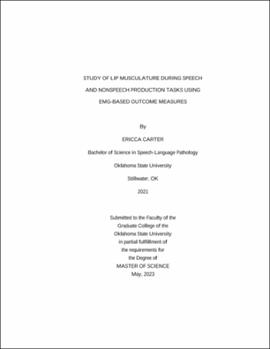| dc.contributor.advisor | Kaipa, Ramesh | |
| dc.contributor.author | Carter, Ericca | |
| dc.date.accessioned | 2023-08-25T20:05:53Z | |
| dc.date.available | 2023-08-25T20:05:53Z | |
| dc.date.issued | 2023-05 | |
| dc.identifier.uri | https://hdl.handle.net/11244/338903 | |
| dc.description.abstract | Non-speech Oral-Motor Exercises (NSOMEs) are oral activities that are thought to influence speech production without actually executing speech (Forrest, 2002). A recurring question among studies investigating the clinical utility of NSOMEs is the possible transfer of treatment effects of NSOMES to speech production (Hodge, 2002; Weismer & Liss, 1991). Despite the ongoing controversy, a majority of speech-language pathologists continue to use NSOMEs to treat speech production deficits. At present, there is insufficient evidence to support or refute the use of NSOMEs. So, it is critical that we continue to investigate the transfer effects of NSOMEs to speech production, if any through empirical approaches. The current study aimed to address this ongoing controversy by employing electromyography (EMG) as the outcome measure. A total of 24 participants in the age range of 19– 27 years participated in the current experiment. All the participants were involved in a series of speech production and comparable nonspeech tasks. Data was collected through EMG sensors that were affixed to participants’ four quadrants of the lips during the speech and nonspeech tasks. The outcome measure was maximum voluntary contraction (MVC), which is an objective measure of the muscle strength and is typically obtained during isometric muscle contractions (Meldrum, Cahalane, Keogan, & Hardiman, 2003). Statistical analyses revealed that there was a significant main effect of the task, lip quadrants, and the stimulus. However, these main effects were qualified by a significant interaction effect between the task and the lip quadrant. The findings suggest that lip musculature behaves differently during speech and nonspeech tasks as evidenced by the %MVC values. The results of this study have implications to influence the use of NSOMEs in clinical practice, and subsequently service delivery models in speech-language pathology. | |
| dc.format | application/pdf | |
| dc.language | en_US | |
| dc.rights | Copyright is held by the author who has granted the Oklahoma State University Library the non-exclusive right to share this material in its institutional repository. Contact Digital Library Services at lib-dls@okstate.edu or 405-744-9161 for the permission policy on the use, reproduction or distribution of this material. | |
| dc.title | Study of lip musculature during speech and nonspeech production tasks using EMG-based outcome measures. | |
| dc.contributor.committeeMember | Tetnowski, John | |
| dc.contributor.committeeMember | Kaipa, Roha | |
| osu.filename | carter_okstate_0664m_18081.pdf | |
| osu.accesstype | Open Access | |
| dc.type.genre | Thesis | |
| dc.type.material | Text | |
| thesis.degree.discipline | Communication Sciences and Disorders | |
| thesis.degree.grantor | Oklahoma State University | |
